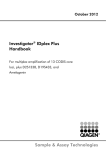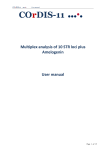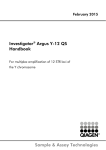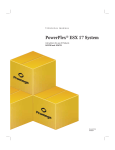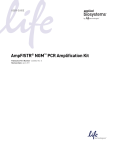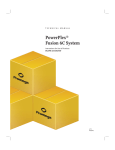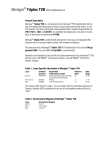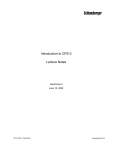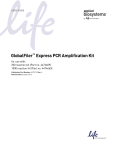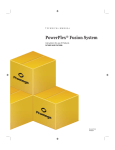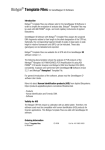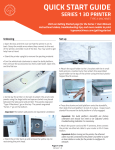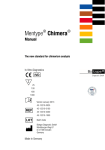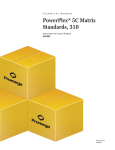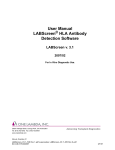Download Sample & Assay Technologies Investigator® ESSplex SE
Transcript
October 2012
Investigator® ESSplex SE Plus
Handbook
For multiplex amplification of the new
European standard set of loci, plus SE33,
and Amelogenin
Sample & Assay Technologies
QIAGEN Sample and Assay Technologies
QIAGEN is the leading provider of innovative sample and assay technologies,
enabling the isolation and detection of contents of any biological sample. Our
advanced, high-quality products and services ensure success from sample to
result.
QIAGEN sets standards in:
Purification of DNA, RNA, and proteins
Nucleic acid and protein assays
microRNA research and RNAi
Automation of sample and assay technologies
Our mission is to enable you to achieve outstanding success and
breakthroughs. For more information, visit www.qiagen.com.
Contents
Kit Contents
4
Storage
4
Intended Use
4
Safety Information
5
Introduction
6
Equipment and Reagents to Be Supplied by User
8
Protocols
PCR Amplification
Electrophoresis Using the ABI PRISM 310 Genetic Analyzer
11
Electrophoresis using the ABI PRISM 3100-Avant/3100
Genetic Analyzer
18
Electrophoresis Using the Applied Biosystems 3130/3130xl
Genetic Analyzer
26
Electrophoresis Using the Applied Biosystems 3500/3500xL
Genetic Analyzer
36
Analysis
47
9
Interpretation of Results
53
Troubleshooting Guide
54
References
57
Ordering Information
58
Investigator ESSplex SE Plus Handbook 10/2012
3
Kit Contents
Investigator ESSplex SE Plus Kit
(100)
(400)
381545
381547
100
400
Fast Reaction Mix*
750 µl
2 x 1500 µl
Primer Mix ESSplex SE Plus
250 µl
4 x 250 µl
Control DNA 9948
200 µl
200 µl
DNA size standard 550 (BTO)
50 µl
200 µl
Allelic ladder ESSplex SE Plus
25 µl
4 x 25 µl
Nuclease-free water
2 x 1.9 ml
5 x 1.9 ml
Quick-Start Protocol
1
1
Catalog no.
Number of 25 µl reactions
* Contains HotStarTaq® Plus DNA Polymerase, dNTPs, MgCl2, and bovine serum albumin (BSA).
Storage
The Investigator ESSplex SE Plus Kit is shipped on dry ice. It should be stored
immediately upon receipt at –20°C in a constant-temperature freezer. Avoid
repeated thawing and freezing. Primer mix and allelic ladder must be stored
protected from the light. DNA samples and post-PCR reagents (allelic ladder
and DNA size standard) should be stored separately from the PCR reagents.
Under these conditions, the components are stable until the expiration date
indicated on the kit.
Once opened, the Investigator ESSplex SE Plus Kit should be stored at 4–8°C for
a maximum of 2 weeks.
Intended Use
The Investigator ESSplex SE Plus Kit is intended for molecular biology
applications in forensic, human identity, and paternity testing. This product is
not intended for the diagnosis, prevention, or treatment of a disease.
All due care and attention should be exercised in the handling of the products.
We recommend all users of QIAGEN products to adhere to the NIH guidelines
that have been developed for recombinant DNA experiments, or to other
applicable guidelines.
4
Investigator ESSplex SE Plus Handbook 10/2012
Safety Information
When working with chemicals, always wear a suitable lab coat, disposable
gloves, and protective goggles. For more information, please consult the
appropriate safety data sheets (SDSs). These are available online in convenient
and compact PDF format at www.qiagen.com/safety where you can find, view,
and print the SDS for each QIAGEN kit and kit component.
24-hour emergency information
Emergency medical information in English, French, and German can be
obtained 24 hours a day from:
Poison Information Center Mainz, Germany
Tel: +49-6131-19240
Investigator ESSplex SE Plus Handbook 10/2012
5
Introduction
The Investigator ESSplex SE Plus Kit is intended for multiplex PCR in forensic
casework. The 15 polymorphic STR markers recommended by the European
Network of Forensic Science Institutes (ENFSI) and the European DNA Profiling
Group (EDNAP) as the new European Standard Set of loci (D1S1656, D2S441,
D2S1338, D3S1358, D8S1179, D10S1248, D12S391, D16S539, D18S51,
D19S433, D21S11, D22S1045, FGA [FIBRA], TH01 [TC11], and vWA), plus
SE33 [ACTBP2], and the gender-specific Amelogenin are amplified
simultaneously.
The Investigator ESSplex SE Plus Kit has been developed specifically for rapid
and reliable generation of DNA profiles from blood, buccal swabs, and forensic
stains. The kit utilizes QIAGEN’s fast-cycling PCR technology, which allows
amplification in 90 minutes and provides highly robust results through its
inhibitor-resistant chemistry. The primers are fluorescence-labeled with one of
the following dyes:
6-FAM™: Amelogenin, TH01, D3S1358, vWA, D21S11
BTG: D16S539, D1S1656, D19S433, SE33
BTY: D10S1248, D22S1045, D12S391, D8S1179, D2S1338
BTR: D2S441, D18S51, FGA
The recommended amount of DNA under standard conditions is 0.5 ng.
Internal validations demonstrated robust and balanced results with 0.2–2 ng
DNA, and reliable results with <0.1 ng DNA.
The Investigator ESSplex SE Plus Kit was validated using the GeneAmp® PCR
System 9700 (with Gold-plated 96-Well Silver Block) and the Applied
Biosystems® 3500™ Genetic Analyzer.
Table 1 shows the STR loci with their chromosomal mapping and repeat motifs
that are concordant with the International Society for Forensic Genetics (ISFG)
guidelines for the use of microsatellite markers (Bär et al., 1997). The
nomenclature for STR Loci D10S1248 and D22S1045 is in accordance with
Hill et al. (2008).
6
Investigator ESSplex SE Plus Handbook 10/2012
Table 1. Locus-specific information of the Investigator ESSplex SE Plus Kit
Locus
GenBank®
accession
number
Repeat motif of the
reference allele
Chromosomal
mapping
Amelogenin X
M55418
–
Xp22.1-22.3
Amelogenin Y
M55419
–
Yp11.2
D1S1656
NC_000001.9 [TAGA]16
1q42
[TGA][TAGA][TAGG]1[TG]5
D2S441
AL079112
[TCTA]12
2p14
D2S1338
G08202
[TGCC]6[TTCC]11
2q35
D3S1358
11449919
TCTA [TCTG]2 [TCTA]15
3p25.3
D8S1179
G08710
[TCTA]12
8q23.1-23.2
D10S1248
AL391869
[GGAA]13
10q26.3
D12S391
G08921
[AGAT]5 GAT [AGAT]7
[AGAC]6 AGAT
12p13.2
D16S539
G07925
[GATA]11
16q24.1
D18S51
L18333
[AGAA]13
18q21.3
D19S433
G08036
AAGG [AAAG] AAGG
TAGG [AAGG]11
19q12
D21S11
AP000433
[TCTA]4 [TCTG]6 [TCTA]3
TA [TCTA]3 TCA [TCTA]2
TCCATA [TCTA]11
21q21.1
D22S1045
AL022314
[ATT]14 ACT [ATT]2
22q12.3
FGA (FIBRA)
M64982
[TTTC]3 TTTTTTCT
[CTTT]13 CTCC [TTCC]2
4q28.2
SE33 (ACTBP2) NG000840
[AAAG]9 AA
[AAAG]16
6q14.2
TH01 (TC11)
D00269
[TCAT]9
11p15.5
vWA
M25858
TCTA [TCTG]4 [TCTA]13
12p13.31
Investigator ESSplex SE Plus Handbook 10/2012
7
Equipment and Reagents to Be Supplied by User
When working with chemicals, always wear a suitable lab coat, disposable
gloves, and protective goggles. For more information, consult the appropriate
material safety data sheets (MSDSs), available from the product supplier.
Hi-Di™ Formamide, 25 ml (Applied Biosystems, cat. no. 4311320)
Matrix Standards BT5 for single-capillary instruments, e.g., ABI PRISM® 310
Genetic Analyzer (QIAGEN cat. no. 386113)
Matrix Standards BT5 for multi-capillary instruments, e.g., ABI PRISM 3100
and Applied Biosystems 3130 and 3500 Genetic Analyzers (QIAGEN cat.
nos. 386123 or 386125)
Pipets and pipet tips
One of the following DNA analyzers:
ABI PRISM 310 Genetic Analyzer
ABI PRISM 3100-Avant™/3100 Genetic Analyzer
Applied Biosystems 3130/3130xl Genetic Analyzer
Applied Biosystems 3500/3500xL Genetic Analyzer
One of the following PCR thermal cyclers:
QIAGEN Rotor-Gene® Q
GeneAmp PCR System 9700
Bio-Rad PTC-200
Biometra UNO-Thermoblock
Eppendorf® Mastercycler® ep
PCR tubes or plates
Validity analysis software for human identification products
Investigator Human Identification PCR Kits require calibration with an allelic
ladder. Therefore, the software used must be compatible with human
identification (HID) products for forensic applications. We recommend
Investigator IDproof, Investigator IDproof Mixture, GeneMapper® ID,
GeneMapper ID-X, or Genotyper® Software. The Investigator Template Files
facilitate data analysis and are valid with the software mentioned above.
8
Investigator ESSplex SE Plus Handbook 10/2012
Protocol: PCR Amplification
This protocol is for PCR amplification of STR loci from forensic samples using
the Investigator ESSplex SE Plus Kit.
Important points before starting
Set up all reaction mixtures in an area separate from that used for DNA
isolation and PCR product analysis (post-PCR).
Use disposable tips containing hydrophobic filters to minimize crosscontamination risks.
Things to do before starting
Before opening the tubes containing PCR components, vortex and then
centrifuge briefly to collect contents at the bottom of the tubes.
The recommended amount of DNA under standard conditions is 0.5 ng.
Internal validations demonstrated robust and balanced results with
0.2–2 ng DNA, and reliable results with <0.1 ng DNA.
Procedure
1. Thaw PCR components and template nucleic acid.
Mix thoroughly before use.
2. Prepare a master mix according to Table 2.
The master mix contains all of the components needed for PCR except the
template (sample) DNA and nuclease-free water.
Prepare a volume of master mix 10% greater than that required for the total
number of PCR assays to be performed. This should include positive and
negative control reactions.
3. Mix the master mix thoroughly, and dispense appropriate volumes
into PCR tubes or the wells of a PCR plate.
4. Add template DNA and nuclease-free water to the master mix, to
give a final sample volume of 25 µl.
5. Prepare positive and negative controls.
Positive control: Use 5 µl of the Control DNA.
Negative control: Use nuclease-free water instead of template DNA in the
reaction.
Investigator ESSplex SE Plus Handbook 10/2012
9
Table 2. Reaction setup
Component
Volume per reaction
Fast Reaction Mix
7.5 µl
Primer Mix
2.5 µl
Nuclease-free water (added in step 4)
Variable
Template DNA (added in step 4)
Variable
Total volume
25 µl
6. Mix reactions thoroughly.
For optimal results, mix the prepared and sealed PCR plate prior to
amplification using an Eppendorf Thermomixer Comfort (orbital shaker) for
5 min at 1200 rpm at room temperature. Use constant shaking without
pauses.
7. Program the thermal cycler according to the manufacturer’s
instructions, using the conditions outlined in Table 3.
Note: If using the GeneAmp PCR System 9700 with an Aluminum Block,
use “Std Mode”, or with a Silver 96-Well Block or Gold-plated Silver
96-Well Block, use “Max Mode”. Do not use “9600 Emulation Mode”.
Table 3. Standard cycling protocol, recommended for all DNA samples
Temperature
Time
Number of cycles
95°C*
5 min
–
96°C
10 s
61°C
120 s
10°C
∞
30 cycles
–
* Hot-start to activate DNA polymerase.
8. After the cycling protocol is completed, store samples at –20°C
protected from the light, or proceed directly with running the
electrophoresis.
10
Investigator ESSplex SE Plus Handbook 10/2012
Protocol: Electrophoresis Using the ABI PRISM 310
Genetic Analyzer
For general instructions on instrument setup, matrix generation, and application
of the GeneScan® or GeneMapper ID Software, refer to the ABI PRISM 310
Genetic Analyzer User’s Manual. Electrophoresis using the GeneScan Software
is described below.
The virtual filter set G5 is used for combined application of the 5 fluorescent
labels 6-FAM, BTG, BTY, BTR, and BTO. This matrix standard is known as BT5.
The materials required for electrophoresis are given in Table 4.
Table 4. Materials required for electrophoresis
Material
Specifications
Capillary
47 cm/50 µm (green)
Polymer
POP-4™ for ABI PRISM 310 Genetic Analyzer
Buffer
10x Genetic Analyzer Buffer with EDTA
Matrix generation
Before conducting DNA fragment size analysis with the filter set G5, a matrix
with the 5 fluorescent labels 6-FAM, BTG, BTY, BTR, and BTO must be
generated (Table 5).
Table 5. The 5 fluorescent labels of BT5
Color
Matrix standard
Blue (B)
6-FAM
Green (G)
BTG
Yellow (Y)
BTY
Red (R)
BTR
Orange (O)
BTO
Investigator ESSplex SE Plus Handbook 10/2012
11
1. Five electrophoresis runs should be conducted, one for each
fluorescent label, under the same conditions as for the samples and
allelic ladders of the Investigator ESSplex SE Plus Kit, in order to
generate suitable matrix files (Table 6).
Table 6. Matrix setup for single capillary instrument (ABI PRISM 310
Genetic Analyzer)
Matrix sample
Component
Volume
Matrix sample 1
Hi-Di Formamide
12.0 µl
Matrix standard 6-FAM
1.0 µl
Hi-Di Formamide
12.0 µl
Matrix standard BTG
1.0 µl
Hi-Di Formamide
12.0 µl
Matrix standard BTY
1.0 µl
Hi-Di Formamide
12.0 µl
Matrix standard BTR
1.0 µl
Hi-Di Formamide
12.0 µl
Matrix standard BTO
1.0 µl
Matrix sample 2
Matrix sample 3
Matrix sample 4
Matrix sample 5
2. Denature for 3 min at 95°C.
3. Snap freeze by placing the plate on ice for 3 min.
Alternatively, the thermal cycler set to 4°C may be used to cool the plate.
4. Load the samples on the tray.
5. Create a Sample Sheet and enter the sample designation. Table 7
shows the injection list for the matrix generation.
12
Investigator ESSplex SE Plus Handbook 10/2012
Table 7. Injection list for matrix generation
Parameter
Settings
Module File
GS STR POP-4 (1 ml) G5
Matrix File
None
Size Standard
None*
Injection Time (s)
5
Injection Voltage (kV)
15
Run Voltage (kV)
15
Run Temperature (°C)
60
Run Time (min)
24
* Always prepare matrix standards without DNA Size Standard (BTO).
Analysis of the matrix samples
1.
2.
3.
4.
5.
6.
Run the GeneScan Software.
Select “New” from the File menu, and then select “Project”.
Open the folder of the current run and select “Add Sample Files”.
Select a matrix sample in the “Sample File” column.
Click “Sample” and then “Raw Data”.
Check the matrix samples for a flat baseline. As shown in the figure
(next page), there should be at least 5 peaks with peak heights of
1000–4000 RFU for each matrix sample.
Note: The optimal range is 2000–4000 RFU.
Investigator ESSplex SE Plus Handbook 10/2012
13
▼ 3200 data points (X)
5500▼
Electropherogram with raw data of the matrix standard 6-FAM.
7. Select an analysis range with a flat baseline and re-inject the matrix
sample, if necessary.
8. Record start and end value (data points) of the analysis range;
e.g., start value 3200, end value 5500.
9. Calculate the difference between the end and start values;
e.g., 5500–3200=2300 data points.
Generation of a matrix
1.
2.
3.
4.
Select “New” in the File menu, and then select “Matrix”.
Import the matrix samples for all dyes (B, G, Y, R, and O).
Enter a “Start At” value, e.g., 3200.
Under “Points”, enter the calculated difference between end and
start values, e.g., 2300.
5. Click “OK” to calculate the new matrix.
Matrix sample selection.
14
Investigator ESSplex SE Plus Handbook 10/2012
6. Select “Save as” in the File menu to save the new matrix in the
matrix folder.
New matrix BT5.
Checking the matrix
1. To check the new matrix with current samples, select “New” in the
File menu, and then select “Project”.
2. Open the folder of the respective run and select “Add Sample Files”.
3. Select the sample(s) in the Sample File column.
4. Click “Sample” and then “Install New Matrix” to open the matrix
folder and select the new matrix.
5. Re-analyze the samples.
Note: There should be no pull-up peaks between the dye panels (B, G, Y,
R, O) with the new matrix.
Sample preparation
1. Set up a mixture of formamide and DNA size standard according to
Table 8.
Table 8. Setup of formamide and DNA size standard mixture
Component
Volume per sample
Hi-Di Formamide
12.0 µl
DNA Size Standard 550 (BTO)
0.5 µl
2.
3.
4.
5.
Aliquot 12 µl of the mixture to a tube for each sample to be analyzed.
Add 1 µl PCR product or allelic ladder (diluted, if necessary).
Denature for 3 min at 95°C.
Snap freeze by placing the plate on ice for 3 min.
Alternatively, the thermal cycler set to 4°C may be used to cool the plate.
6. Load the samples on the tray.
Investigator ESSplex SE Plus Handbook 10/2012
15
Setting up the GeneScan Software
Create a Sample Sheet and enter sample designation.
Table 9. Injection list for the ABI PRISM 310 Genetic Analyzer
Component
Settings
Module File
GS STR POP-4 (1 ml) G5
Matrix File
e.g., Matrix BT5
Size Standard
e.g., SST-BTO_60-500bp
Injection Time (s)
5*
Injection Voltage (kV)
15
Run Voltage (kV)
15
Run Temperature (°C)
60
Run Time (min)
28†
* Deviating from standard settings, the injection time may range between 1 and 10 s
depending on the type of sample. If samples with very high signal intensities are recorded, a
shorter injection time may be selected. For samples with low DNA content, an injection time
up to 10 s may be necessary.
†
The run time for Investigator ESSplex SE Plus was modified in order to be able to analyze
fragments with lengths of up to 500 bp.
16
Investigator ESSplex SE Plus Handbook 10/2012
Analysis parameters
Table 10 lists the recommended analysis parameters.
Table 10. Recommended analysis parameters for the ABI PRISM 310
Genetic Analyzer
Parameter
Settings
Analysis Range
Start: 2000
Stop: 10,000
Data Processing
Baseline: Checked
Multi-component: Checked
Smooth options: Light
Peak Detection
Peak Amplitude Thresholds
B:*
Y:*
G:* R:*
O:*
Min. Peak Half Width: 2 pts
Polynomial Degree: 3
Peak Window Size: 11 pts†
Size Call Range
Min: 60
Max: 550
Size Calling Method
Local Southern Method
Split Peak Correction
None
* The peak amplitude threshold (cutoff value) corresponds to the minimum peak height that will be
detected by the GeneScan or GeneMapper ID Software. Thresholds are usually 50–200 RFU and
should be determined individually by the laboratory. Recommendation: The minimal peak height
should be 3-times as high as the background noise of the baseline.
†
Only the setting for Peak Window Size is different to defaults from Applied Biosystems for
HID analysis.
Note: For information on the use of the recommended Template Files (as
analysis parameters), refer to the appropriate Investigator Template Files User
Guide (Genotyper, GeneMapper ID, or GeneMapper ID-X).
Investigator ESSplex SE Plus Handbook 10/2012
17
Protocol: Electrophoresis using the ABI PRISM 3100Avant/3100 Genetic Analyzer
For detailed instructions on instrument setup, spectral calibration, application of
the ABI PRISM 3100 Data Collection software version 1.01 or 1.1 and the
GeneScan software, refer to the ABI PRISM 3100-Avant/3100 Genetic Analyzer
User’s Manual.
The system with 4 capillaries is the ABI PRISM 3100-Avant Genetic Analyzer and
the system with 16 capillaries is the ABI PRISM 3100 Genetic Analyzer.
The virtual filter set G5 is used for combined application of the 5 fluorescent
labels 6-FAM, BTG, BTY, BTR, and BTO. This matrix standard is known as BT5.
The materials required for electrophoresis are given in Table 11.
Table 11. Materials required for electrophoresis
Material
Specifications
Capillary
36 cm Capillary Array for ABI PRISM 3100Avant/3100 Genetic Analyzer
Polymer
POP-4 Polymer for ABI PRISM 3100-Avant/3100
Genetic Analyzer
Buffer
10x Genetic Analyzer Buffer with EDTA
Spectral calibration/matrix generation
Proper spectral calibration is critical for evaluation of multicolor systems with the
ABI PRISM 3100-Avant/3100 Genetic Analyzer and should be done before
conducting fragment length analysis. The calibration procedure creates a matrix
which is used to correct the overlapping of fluorescence emission spectra of the
dyes.
Spectral calibration comprises the following steps:
Preparaing the spectral calibration standards
Loading the standards to the 96-well reaction plate (one sample per
capillary)
Entering the plate composition
Performing a spectral calibration run and checking the matrix
18
Investigator ESSplex SE Plus Handbook 10/2012
Preparing the spectral calibration standards
Example for 4 capillaries (ABI PRISM 3100-Avant Genetic Analyzer)
1. Set up a mixture of formamide and Matrix Standard BT5 according to
Table 12.
Table 12. Setup of formamide and Matrix Standard BT5 mixture for
4 capillaries
Component
Volume
Hi-Di Formamide
60 µl
Matrix Standard BT5 multi cap.
5 µl
2. Load 12 µl of the mixture to 96-well plate; e.g., positions A1–D1.
3. Denature for 3 min at 95°C.
4. Snap freeze by placing the plate on ice for 3 min.
Alternatively, the thermal cycler set to 4°C may be used to cool the plate.
Example for 16 capillaries (ABI PRISM 3100 Genetic Analyzer)
1. Set up a mixture of formamide and Matrix Standard BT5 according to
Table 13.
Table 13. Setup of formamide and Matrix Standard BT5 mixture for
16 capillaries
Component
Volume
Hi-Di Formamide
204 µl
Matrix Standard BT5 multi cap.
17 µl
2. Load 12 µl of the mixture to 96-well plate; e.g., positions A1–H1 and
A2–H2.
3. Denature for 3 min at 95°C.
4. Snap freeze by placing the plate on ice for 3 min.
Alternatively, the thermal cycler set to 4°C may be used to cool the plate.
Investigator ESSplex SE Plus Handbook 10/2012
19
Performing a spectral calibration run
The parameter file for DyeSetG5 must be modified once to achieve successful
calibration with the Data Collection Software version 1.0.1 or 1.1.
Spectral parameter
1. To change settings in the parameter file, go to the following path:
D:\AppliedBio\Support Files\Data Collection
SupportFiles\CalibrationData\Spectral Calibration\ParamFiles
2. Select “MtxSTD{Genescan_SetG5} to open the PAR file.
3. Change “Condition Bounds Range” to [1.0, 20.0].
4. If the calibration was unsuccessful, also change Sensitivity to 0.1 and
Quality to 0.8.
5. Select “Save As” in the File menu and save the parameter file under
a new name; e.g., MtxStd{Genescan_SetG5_BT5}.par.
Note: Always use this parameter file for spectral calibration runs using
QIAGEN Matrix Standard BT5.
Plate Editor for spectral calibration
1.
2.
3.
4.
5.
6.
Place the 96-well plate on the autosampler tray.
Run the ABI PRISM 3100 Data Collection Software.
In Plate View, click “New” to open the Plate Editor dialog box.
Enter a name for the plate.
Select a Spectral Calibration.
Select “96-Well” as plate type, and click “Finish”.
Table 14. Plate Editor for spectral calibration
Parameter
Settings
Sample Name
Enter name for the matrix samples
Dye Set
G5
Spectral Run Module
Default (e.g., Spect36_POP4)
Spectral Parameters
MtxStd{GeneScan_SetG5_BT5}.par
(parameters created before)
7. Click the column header to select the entire column, and select “Fill
Down” from the Edit menu to apply the information to the selected
samples. Confirm by clicking “OK”.
20
Investigator ESSplex SE Plus Handbook 10/2012
8. Link the reaction plate on the autosampler tray with the created
plate ID and start the run.
9. Upon completion of the run, check in the Spectral Calibration Result
dialog box that all capillaries have successfully passed calibration
(label A).
If individual capillaries are labeled X, refer to the ABI PRISM 3100-Avant/
3100 Genetic Analyzer User’s Manual.
10. Click “OK” to confirm completion of the run.
Checking the matrix
1. Select “Display Spectral Calibration” from the Tools menu, then “Dye
Set” and “G5” to review the spectral calibration profile for each
capillary.
2. The quality value (Q value) must be greater than 0.95 and the
condition number (C value) must be between 1 and 20. Both values
must be within the predetermined range.
3. Check for a flat baseline in the matrix samples. There should be 5
peaks with heights of 1000–5000 RFU in each matrix sample.
Note: The optimal range is 2000–4000 RFU.
4. Check the new matrix with the current samples. There should be no
pull-up peaks between the dye panels (B, G, Y, R, and O) with the
new matrix.
5. If the calibration failed, follow instructions in the section “Spectral
parameter” on page 20.
6. If all capillaries have passed the calibration, the last calibration file
for Dye Set G5 must be activated manually. Click “Set Active Spectral
Calibration” under the Tools menu.
7. Rename the calibration file under Set Matrix Name (e.g., BT5_Date of
calibration).
Sample preparation
1. Set up a mixture of formamide and DNA size standard according to
Table 15.
Table 15. Setup of formamide and DNA size standard mixture
Component
Volume per sample
Hi-Di Formamide
12 µl
DNA Size Standard 550 (BTO)
0.5 µl
Investigator ESSplex SE Plus Handbook 10/2012
21
2. Aliquot 12 µl of the mixture to a tube for each sample to be
analyzed.
3. Add 1 µl PCR product or allelic ladder (diluted, if necessary).
4. Denature for 3 min at 95°C.
5. Snap freeze by placing the plate on ice for 3 min.
Alternatively, the thermal cycler set to 4°C may be used to cool the plate.
6. Load the samples on the tray.
Since injections take place simultaneously on all capillaries, 4 or 16 samples
must be pipetted onto the plate of multi-capillary analyzers. If fewer samples
are analyzed, the empty positions must be filled with 12 µl Hi-Di Formamide.
To ensure a reliable allelic assignment on multi-capillary analyzers, several
ladders should be run.
Room temperature may influence the performance of PCR products on multicapillary instruments, so that shoulder peaks or split peaks occur especially at
low temperatures. Ensure ambient conditions are kept as recommended by the
instrument manufacturer.
Setting up the GeneScan Software
1. Edit the default run module in Dye Set G5 once for the first run.
Select “Module Editor” to open the dialog box.
2. Select the appropriate Run Module as template from the GeneScan
table (see Table 16).
3. Modify the Injection Voltage to 3 kV and the Injection Time to 10 s.
4. Click “Save As” and enter the name of the new module
(e.g., 3kV_10s_500bp). Confirm by clicking “OK”.
5. Click “Close” to exit the Run Module Editor.
22
Investigator ESSplex SE Plus Handbook 10/2012
Table 16. Run Module 3kV_10s_500bp for the ABI PRISM 3100Avant/3100 Genetic Analyzer
Parameter
Setting
Run Temperature (°C)
Default
Cap Fill Volume
Default
Maximum Current (A)
Default
Current Tolerance (A)
Default
Run Current (A)
Default
Voltage Tolerance (kV)
Default
Pre-Run Voltage (kV)
Default
Pre-Run Time (s)
Default
Injection Voltage (kV)
3.0
Injection Time (s)
10*
Run Voltage (kV)
Default
Number of Steps
Default
Voltage Step Interval
Default
Data Delay Time (s)
Default
Run Time (min)
26†
* Deviating from the standard settings, the injection time may range between 1 and 20 s
depending on the type of sample. If samples with very high signal intensities are recorded, a
shorter injection time may be selected. For samples with low DNA content, an injection time
of up to 20 s may be necessary.
†
The run time for Investigator ESSplex SE Plus was modified in order to be able to analyze
fragments with lengths of up to 500 bp.
Starting the run
1.
2.
3.
4.
5.
6.
Place the prepared 96-well plate on the autosampler tray.
Run the ABI PRISM 3100 Data Collection Software.
In Plate View, click “New” to open the Plate Editor dialog box.
Enter a name for the plate.
Select “GeneScan” as the application type.
Select “96-Well” as plate type, and click “Finish”.
Investigator ESSplex SE Plus Handbook 10/2012
23
Table 17. Settings in Plate Editor
Parameter
Settings
Sample Name
Enter name for the matrix samples
Dyes
O
Color Info
Ladder or sample
Project Name
e.g., 3100_Project1
Dye Set
G5
Run Module
3kV_10s_500bp*
Analysis Module 1
DefaultAnalysis.gsp
* See Table 16, “Run Module 3kV_10s_500bp for the ABI PRISM 3100-Avant/3100 Genetic
Analyzer”.
7. Complete the table in the Plate Editor and click “OK”.
8. Click the column header to highlight the entire column and select
“Fill Down” from the Edit menu to apply the information to the
selected samples.
9. Link the reaction plate on the autosampler tray to the created plate
ID and start the run.
10. Upon completion of the run, view the data as Color Data in the
Array View of the 3100 Data Collection Software or as Analyzed
Sample Files under D:/AppliedBio/3100/DataExtractor/ExtractRuns.
24
Investigator ESSplex SE Plus Handbook 10/2012
Analysis parameters
Table 18 lists the recommended analysis parameters.
Table 18. Recommended analysis parameters for the ABI PRISM 3100Avant/3100 Genetic Analyzer
Parameter
Settings
Analysis Range
Start: 2000
Stop: 10,000
Data Processing
Baseline: Checked
Multi-component: Checked
Smooth options: Light
Peak Detection
Peak Amplitude Thresholds
B:*
Y:*
G:* R:*
O:*
Min. Peak Half Width: 2 pts
Polynomial Degree: 3
Peak Window Size: 11 pts†
Size Call Range
Min: 60
Max: 550
Size Calling Method
Local Southern Method
Split Peak Correction
None
* The peak amplitude threshold (cutoff value) corresponds to the minimum peak height that will be
detected by the GeneScan or GeneMapper ID Software. Thresholds are usually 50–200 RFU and
should be determined individually by the laboratory. Recommendation: The minimal peak height
should be 3-times higher than the background noise of the baseline.
†
Only the setting for Peak Window Size is different to defaults from Applied Biosystems for
HID analysis.
Note: For information on the use of the recommended Template Files (as
analysis parameters), refer to the appropriate Investigator Template Files User
Guide (Genotyper, GeneMapper ID, or GeneMapper ID-X).
Investigator ESSplex SE Plus Handbook 10/2012
25
Protocol: Electrophoresis Using the Applied
Biosystems 3130/3130xl Genetic Analyzer
For detailed instructions on instrument setup, spectral calibration, or application
of the ABI PRISM Data Collection Software version 3.0 and the GeneMapper ID
Software, refer to the Applied Biosystems 3130/3130xl Genetic Analyzers
Getting Started Guide.
The system with 4 capillaries is the Applied Biosystems 3130 Genetic Analyzer
and the system with 16 capillaries is the Applied Biosystems 3130xl Genetic
Analyzer.
The virtual filter set Any5Dye is used for combined application of the 5
fluorescent labels 6-FAM, BTG, BTY, BTR, and BTO. This matrix standard is
known as BT5.
The materials required for electrophoresis are given in Table 19.
Table 19. Materials required for electrophoresis
Material
Specifications
Capillary
36 cm Capillary Array for Applied Biosystems
3130/3130xl Genetic Analyzer
Polymer
POP-4 Polymer for Applied Biosystems 3130/3130xl
Genetic Analyzer
Buffer
10x Genetic Analyzer Buffer with EDTA
Spectral calibration/matrix generation
Before conducting DNA fragment size analysis, it is necessary to perform a
spectral calibration with the 5 fluorescent labels 6-FAM, BTG, BTY, BTR, and
BTO for each analyzer. The calibration procedure creates a matrix which is
used to correct the overlapping of fluorescence emission spectra of the dyes.
Spectral calibration is comprised of the following steps:
Preparing the spectral calibration standards
Loading the standards to the 96-well reaction plate (one sample per
capillary)
Creating the instrument protocol for spectral calibration (Protocol Manager)
Defining the plate composition in the plate editor (Plate Manager)
Performing a spectral calibration run and checking the matrix
26
Investigator ESSplex SE Plus Handbook 10/2012
Preparing the spectral calibration standards
Example for 4 capillaries (Applied Biosystems 3130 Genetic Analyzer)
1. Set up a mixture of formamide and Matrix Standard BT5 according to
Table 20.
Table 20. Setup of formamide and Matrix Standard BT5 mixture for
4 capillaries
Component
Volume
Hi-Di Formamide
60 µl
Matrix Standard BT5 multi cap.
5 µl
2. Load 12 µl of the mixture to 96-well plate, e.g., positions A1–D1.
3. Denature for 3 min at 95°C.
4. Snap freeze by placing the plate on ice for 3 min.
Alternatively, the thermal cycler set to 4°C may be used to cool the plate.
Example for 16 capillaries (Applied Biosystems 3130xl Genetic Analyzer)
1. Set up a mixture of formamide and Matrix Standard BT5 according to
Table 21.
Table 21. Setup of formamide and Matrix Standard BT5 mixture for
16 capillaries
Component
Volume
Hi-Di Formamide
204 µl
Matrix Standard BT5 multi cap.
17 µl
2. Load 12 µl of the mixture to 96-well plate, e.g., positions A1–H1 and
A2–H2.
3. Denature for 3 min at 95°C.
4. Snap freeze by placing the plate on ice for 3 min.
Alternatively, the thermal cycler set to 4°C may be used to cool the plate.
Investigator ESSplex SE Plus Handbook 10/2012
27
Performing spectral calibration run
1. Place the 96-well plate on the autosampler tray.
2. In the Protocol Manager of the Data Collection Software, open the
Instrument Protocol window.
3. Click “New” to open the Protocol Editor dialog box.
4. Complete the dialog box with information from Table 22 and click
“OK”.
Table 22. Instrument protocol for spectral calibration
Protocol Editor
Settings
Name
User (e.g., Spectral36_POP4_BT5)
Type
SPECTRAL
Dye Set
Any5Dye
Polymer
User (e.g., POP4)*
Array Length
User (e.g., 36cm)*
Chemistry
Matrix Standard
Run Module
Default (e.g., Spect36_POP4_1)*
* Depends on the type of polymer and length of capillary used.
5. Click “New” in the Plate Manager of the Data Collection Software to
open the New Plate Dialog box.
6. Enter information from Table 23 and click “OK”. A new table in the
Plate Editor opens automatically (Table 24).
Table 23. Plate Editor for spectral calibration (I)
New plate dialog
Settings
Name
e.g., Spectral_BT5_date
Application
Spectral Calibration
Plate Type
96-well
Owner Name/
Operator Name
…
28
Investigator ESSplex SE Plus Handbook 10/2012
Table 24. Plate Editor for spectral calibration (II)
Parameter
Settings
Sample Name
Enter name for the matrix samples
Priority
e.g., 100
Instrument Protocol 1
Spectral36_POP4_BT5 (setting described before)
7. Click the column header to select the entire column, and select “Fill
Down” from the Edit menu to apply the information to the selected
samples. Confirm by clicking “OK”.
8. Link the reaction plate on the autosampler tray with the created
plate ID (position A or B) and start the run.
O
R
Y
G
B
Electropherogram of spectral calibration with matrix standard BT5 on an Applied
Biosystems 3130 Genetic Analyzer.
Investigator ESSplex SE Plus Handbook 10/2012
29
Checking the matrix
1. The quality value (Q value) of each capillary must be greater than
0.95 and the condition number range (C value) must be between 1
and 20.
2. Check for a flat baseline in the matrix samples. As shown in the
figure on the previous page, there should be 5 peaks with peak
heights of about 1000–5000 RFU in each matrix sample.
Note: The optimal range is 2000–4000 RFU.
3. Check the new matrix with the current samples. There should be no
pull-up peaks between the dye panels (B, G, Y, R, O) with the new
matrix.
4. If calibration failed, use the optimized values of the Matrix Standard
BT5 and repeat the calibration run.
5. If all capillaries have passed the test, the last calibration file for the
Dye Set Any5Dye is activated automatically in the Spectral Viewer.
Rename the calibration file (e.g., BT5_Date of calibration).
Sample preparation
1. Set up a mixture of formamide and DNA size standard according to
Table 25.
Table 25. Setup of formamide and DNA size standard mixture
Component
Volume per sample
Hi-Di Formamide
12.0 µl
DNA Size Standard 550 (BTO)
0.5 µl
2. Aliquot 12 µl of the mixture to a tube for each sample to be
analyzed.
3. Add 1 µl PCR product or allelic ladder (diluted, if necessary).
4. Denature for 3 min at 95°C.
5. Snap freeze by placing the plate on ice for 3 min.
Alternatively, the thermal cycler set to 4°C may be used to cool the plate.
6. Load the samples on the tray.
30
Investigator ESSplex SE Plus Handbook 10/2012
Since injections take place simultaneously on all capillaries, 4 or 16 samples
must be pipetted onto the plate of multi-capillary analyzers. If fewer samples
are analyzed, the empty positions must be filled with 12 µl Hi-Di Formamide.
To ensure a reliable allelic assignment on multi-capillary analyzers, several
ladders should be run.
Room temperature may influence the performance of PCR products on multicapillary instruments, so that shoulder peaks or split peaks occur especially at
low temperatures. Ensure ambient conditions are kept, as recommended by the
instrument manufacturer.
Setting up the Data Collection Software
1. Edit the Run Module once for the first run. In the Module Manager of
the Data Collection Software, click “New” to open the Run Module
Editor dialog box.
Note: Modify the Run Module Default settings from
“HIDFragmentAnalysis36_POP4_1” to those shown in Table 26.
2. Modify the Injection Voltage to 3 kV and the Injection Time to 10 s
(Table 26).
3. Click “Save As”, enter a name for the new Run Module
(e.g., 3kV_10s_500bp), and confirm by clicking “OK”.
4. Click “Close” to exit the Run Module Editor.
Investigator ESSplex SE Plus Handbook 10/2012
31
Table 26. Run Module 3kV_10s_500bp for the Applied Biosystems
3130/3130xl Genetic Analyzer
Parameter
Settings
Oven Temperature (°C)
Default
Poly Fill Volume
Default
Current Stability (µA)
Default
Pre-Run Voltage (kV)
Default
Pre-Run Time (s)
Default
Injection Voltage (kV)
3.0
Injection Time (s)
10*
Voltage Number of Steps
Default
Voltage Step Interval
Default
Data Delay Time (s)
Default
Run Voltage (kV)
Default
Run Time (s)
1560†
* Deviating from the standard settings, the injection time may range between 1 and 20 s
depending on the type of sample. If samples with very high signal intensities are recorded, a
shorter injection time may be selected. For samples with low DNA content, an injection time
of up to 20 s may be necessary.
†
The run time for Investigator ESSplex SE Plus was modified in order to be able to analyze
fragments with lengths of up to 500 bp.
Starting the run
1. Place the prepared 96-well plate on the autosampler tray.
2. Open the Protocol Manager of the Data Collection Software.
3. Click “New” in the Instrument Protocol window to open the Protocol
Editor dialog box and enter the information in Table 27.
4. Click “OK” to exit the Protocol Editor.
32
Investigator ESSplex SE Plus Handbook 10/2012
Table 27. Settings in Instrument Protocol
Protocol Editor
Settings
Name
Run36_POP4_BT5_26min
Type
REGULAR
Run Module
3kV_10s_500bp*
Dye Set
Any5Dye
* See Table 26, “Run Module 3kV_10s_500bp for the Applied Biosystems 3130/3130xl
Genetic Analyzer”.
1. Before each run, it is necessary to create a plate definition. In the
Plate Manager of the Data Collection Software, click “New” to open
the New Plate Dialog box.
2. Enter the information in Table 28.
Table 28. GeneMapper Plate Editor (I)
Protocol Editor
Settings
Name
e.g., Plate_BT5_Date
Application
Select GeneMapper Application
Plate type
96-Well
Owner Name/
Operator Name
…
3. Click “OK” and a new table in the Plate Editor opens automatically
(Table 29).
4. Click the column header to select the entire column. Select “Fill
Down” from the Edit menu to apply the information to all selected
samples. Click “OK”.
5. In the Run Scheduler, click “Find All”, and select “Link” to link the
reaction plate on the autosampler tray to the newly created plate
record (position A or B).
Investigator ESSplex SE Plus Handbook 10/2012
33
Table 29. GeneMapper Plate Editor (II)
Parameter
Settings
Sample Name
Enter the name for the samples
Priority
e.g., 100 (Default)
Sample Type
Sample or Allelic Ladder
Size Standard
e.g., SST-BTO_60-500bp
Panel
e.g., ESSplex_SE_Plus_Panels
Analysis Method
e.g., Analysis_HID_3130
Snp Set
–
User-defined 1-3
–
Results Group 1
(Select results group)
Instrument Protocol 1
Run36_POP4_BT5_26min (setting described
before)
6. Start the run.
7. During the run, view Error Status in the Event Log or examine the
quality of the raw data for each capillary in the Capillaries Viewer or
the Cap/Array Viewer.
8. View data as an overview in Run History or Cap/Array Viewer of the
Data Collection Software.
Run data are saved in the Run Folder of the previously chosen Result Group.
34
Investigator ESSplex SE Plus Handbook 10/2012
Analysis parameters/analysis method
Table 30 lists the recommended analysis parameters.
Table 30. Recommended settings for the Applied Biosystems
3130/3130xl Genetic Analyzer
Parameter
Settings
Peak Detection Algorithm
Advanced
Ranges
Analysis: Partial Range
Start Point: 2000; Stop Point: 10,000
Sizing: All Sizes
Smoothing and Baselining
Smoothing: Light
Baseline Window: 51 pts
Size Calling Method
Local Southern Method
Peak Detection
Peak Amplitude Thresholds
B:*
Y:*
G:* R:*
O:*
Min. Peak Half Width: 2 pts
Polynomial Degree: 3
Peak Window Size: 11 pts†
Slope Thresholds: 0.0
* The peak amplitude threshold (cutoff value) corresponds to the minimum peak height that
will be detected by the GeneMapper ID Software. The thresholds are usually 50–200 RFU
and should be determined individually by the laboratory. Recommendation: The minimal
peak height should be 3-times higher than the background noise of the baseline.
†
Only the setting for Peak Window Size is different to defaults from Applied Biosystems for
HID analysis.
Note: For information on the use of the recommended Template Files (as
analysis parameters), refer to the appropriate Investigator Template Files User
Guide (Genotyper, GeneMapper ID, or GeneMapper ID-X).
Investigator ESSplex SE Plus Handbook 10/2012
35
Protocol: Electrophoresis Using the Applied
Biosystems 3500/3500xL Genetic Analyzer
For detailed instructions on instrument setup, spectral calibration, or application
of the Applied Biosystems 3500 Series Data Collection Software version 1.0 and
the GeneMapper ID-X Software version 1.2, refer to the Applied Biosystems
3500/3500xL Genetic Analyzers User Guide.
The system with 8 capillaries is the Applied Biosystems 3500 Genetic Analyzer
and the system with 24 capillaries is the Applied Biosystems 3500xL Genetic
Analyzer.
The virtual filter set AnyDye is used for combined application of the 5
fluorescent labels 6-FAM, BTG, BTY, BTR, and BTO. This matrix standard is
known as BT5.
The materials required for electrophoresis are given in Table 31.
Table 31. Materials required for electrophoresis
Material
Specifications
Capillary
36 cm Array for Applied Biosystems 3500/3500xL
Genetic Analyzer
Polymer
POP-4 for Applied Biosystems 3500/3500xL
Genetic Analyzer
Buffer
Anode Buffer Container (ABC) 3500 Series
Cathode Buffer Container (CBC) 3500 Series
Spectral calibration/matrix generation
Before conducting DNA fragment size analysis, it is necessary to perform a
spectral calibration with the 5 fluorescent labels 6-FAM, BTG, BTY, BTR, and
BTO for each analyzer (Table 32). The calibration procedure creates a matrix
which is used to correct the overlapping of fluorescence emission spectra of the
dyes.
IMPORTANT: Spectral calibration must be performed for each new capillary
array.
Spectral calibration consists of the following steps:
Preparation of the instrument
Preparation of dye set BT5
Preparation of the standard calibration plate
Plate assembly and loading the plate in the instrument
36
Investigator ESSplex SE Plus Handbook 10/2012
Performing a spectral calibration run
Checking the matrix
Preparation of the instrument
Before the spectral calibration process, ensure that the spatial calibration has
been performed. This process is described in detail in the Applied Biosystems
3500/3500xL Genetic Analyzers User Guide.
Preparation of dye set BT5
Table 32. The 5 fluorescent labels of BT5
Color
Matrix standard
Blue (B)
6-FAM
Green (G)
BTG
Yellow (Y)
BTY
Red (R)
BTR
Orange (O)
BTO
Prior to the spectral calibration, a dye set for the Matrix Standard BT5 must be
set up.
1. To create a new dye set, go to “Library” and select “Analyze”,
followed by “Dye Sets” and click “Create”.
2. Enter a “Dye Set Name”, e.g. BT5.
3. Select “Matrix Standard” as a chemistry and “AnyDye Template” as a
dye set template.
4. Disable “Purple” in the field “Arrange Dyes”. Ensure that all other
colors are enabled.
5. Under “Calibration Peak Order” the colors need to be arranged as
follows: 5 – blue, 4 – green, 3 – yellow, 2 – red, and 1 – orange.
6. Do not alter the “Parameter” settings.
7. Click “Save” to confirm the changes.
Investigator ESSplex SE Plus Handbook 10/2012
37
Setup of dye set BT5.
Preparation of the standard calibration plate
Example for 8 capillaries (Applied Biosystems 3500 Genetic Analyzer)
1. Set up a mixture of formamide and Matrix Standard BT5 according to
Table 33.
Table 33. Setup of formamide and Matrix Standard BT5 mixture for
8 capillaries
Component
Volume
Hi-Di Formamide
90 µl
Matrix Standard BT5 multi cap.
10 µl
38
Investigator ESSplex SE Plus Handbook 10/2012
2. Load 10 µl of the mixture to a 96-well plate, e.g., positions A1–H1.
3. Denature for 3 min at 95°C.
4. Snap freeze by placing the plate on ice for 3 min.
Alternatively, the thermal cycler set to 4°C may be used to cool the plate.
Example for 24 capillaries (Applied Biosystems 3500xL Genetic Analyzer)
1. Set up a mixture of formamide and Matrix Standard BT5 according to
Table 34.
Table 34. Setup of formamide and Matrix Standard BT5 mixture for
24 capillaries
Component
Volume
Hi-Di Formamide
225 µl
Matrix Standard BT5 multi cap.
25 µl
2. Load 10 µl of the mixture to a 96-well plate, e.g., positions A1–H1,
A2–H2, and A3–H3.
3. Denature for 3 min at 95°C.
4. Snap freeze by placing the plate on ice for 3 min.
Alternatively, the thermal cycler set to 4°C may be used to cool the plate.
Plate assembly and loading the plate in the instrument
The necessary steps are described in detail in the Applied Biosystems
3500/3500xL Genetic Analyzers User Guide.
Performing a spectral calibration run
Once the multiwell plates containing the spectral calibration mixture are placed
in the autosampler tray, the spectral calibration process can be started.
1. To access the Spectral Calibration screen, select “Maintenance” on
the Dashboard of the 3500 Series Data Collection software.
2. The number of wells in the spectral calibration plate and their
location in the instrument must be specified.
3. Select “Matrix Standard” as a chemistry standard and “BT5” for dye
set.
4. (Optional) Enable “Allow Borrowing”.
5. Click “Start Run”.
Investigator ESSplex SE Plus Handbook 10/2012
39
Checking the matrix
Click a capillary in the table in order to display the results for each capillary
(spectral data, Quality value, and Condition Number) below the run results table.
The quality value (Q value) of each capillary must be greater than 0.8 and
the number range (C value) must be between 1 and 20.
Check the matrix samples for a flat baseline. As shown in the figure, there
should be 5 peaks with peak heights of about 1000–5000 RFU for each
matrix sample (Note: The optimal range is 2000–4000 RFU).
Electropherogram of spectral calibration of the matrix standard BT5 on an Applied
Biosystems 3500 Genetic Analyzer.
When a spectral calibration is successfully completed, the “Overall” row
displays green results. If the “Overall” row displays red results, refer to the
“spectral calibration troubleshooting” section of the Applied Biosystems
3500/3500xL Genetic Analyzers User Guide.
Example of successful spectral calibration of the matrix standard BT5 for all capillaries
on an Applied Biosystems 3500 Genetic Analyzer.
40
Investigator ESSplex SE Plus Handbook 10/2012
For each capillary, select and display the spectral and raw data. Check that the
data meet the following criteria:
The order of the peaks in the spectral profile from left to right read orangered-yellow-green-blue
No extraneous peaks appear in the raw data profile
Peak morphology in the spectral profile shows no gross overlaps, dips, or
other irregularities. Separate and distinct peaks should be visible
If the data for all capillaries meet the criteria above, click “Accept Results”. If
any capillary data does not meet the criteria above, click “Reject Results”, and
refer to the “spectral calibration troubleshooting” section of the Applied
Biosystems 3500/3500xL Genetic Analyzers User Guide.
Sample preparation
1. Set up a mixture of formamide and DNA size standard according to
Table 35.
Table 35. Setup of formamide and DNA size standard mixture
Component
Volume per sample
Hi-Di Formamide
12.0 µl
DNA Size Standard 550 (BTO)
0.5 µl
2. Aliquot 12 µl of the mixture to a tube for each sample to be
analyzed.
3. Add 1 µl PCR product or allelic ladder (diluted, if necessary).
4. Denature for 3 min at 95°C.
5. Snap freeze by placing the plate on ice for 3 min.
Alternatively, the thermal cycler set to 4°C may be used to cool the plate.
6. Load the samples on the tray.
Since injections take place simultaneously on all capillaries, 8 or 24 samples
must be pipetted onto the plate of multi-capillary analyzers. If fewer samples
are analyzed, the empty positions must be filled with 12 µl Hi-Di Formamide.
Investigator ESSplex SE Plus Handbook 10/2012
41
To ensure a reliable allelic assignment on multi-capillary analyzers, inject one
allelic ladder for each set of 24 samples:
8-capillary instruments: One allelic ladder per 3 injections
24-capillary instruments: One allelic ladder per 1 injection
Room temperature may influence the performance of PCR products on multicapillary instruments, so that shoulder peaks or split peaks occur, especially at
low temperatures. Ensure ambient conditions are kept, as recommended by the
instrument manufacturer.
Setting up a run
If you are using the Investigator ESSplex SE Plus Kit for the first time on an
Applied Biosystems 3500 Genetic Analyzer, you will first need to set up a
number of protocols:
Instrument Protocol
Size Standard
QC Protocol
Assay
All protocols can be set up via the Dashboard of the 3500 Series Data
Collection software.
1. To set up the Instrument Protocol, go to “Library” and select
“Analyze”, followed by “Instrument Protocols” and click “Create”.
Note: Modify the Run Module Default settings from “HID36_POP4” as
shown in Table 36.
2. The parameters in Table 36 must be entered or selected.
42
Investigator ESSplex SE Plus Handbook 10/2012
Table 36. Instrument Protocol parameters for the Applied Biosystems
3500/3500xL Genetic Analyzer
Parameter
Setting
Application Type
HID
Capillary Length
36 cm
Polymer
POP4
Dye Set
e.g., BT5
Run Module
HID36_POP4
Protocol Name
e.g., Investigator ESSplex SE Plus
Oven Temperature (°C)
Default
Run Voltage (kV)
Default
PreRun Voltage (kV)
Default
Injection Voltage (kV)
3.0
Run Time (s)
1300
PreRun Time (s)
Default
Injection Time (s)
8.0*
Data Delay (s)
Default
Advanced Options
Default
* Deviating from the standard settings, the injection time may range between 1 and 20 s
depending on the type of sample. If samples with very high signal intensities are recorded, a
shorter injection time may be selected. For samples with low DNA content, an injection time
of up to 20 s may be necessary.
3. Click “Save” to confirm the changes.
4. To set up the Size Standard, go to “Library”, select “Analyze”,
followed by “Size Standards”, and click “Create”.
5. The parameters in Table 37 must be entered or selected.
The DNA Size Standard 550 (BTO) should be used with the following
lengths of fragments: 60, 80, 90, 100, 120, 140, 160, 180, 200, 220,
240, 250, 260, 280, 300, 320, 340, 360, 380, 400, 425, 450, 475, 500,
525, and 550 bp.
Investigator ESSplex SE Plus Handbook 10/2012
43
Table 37. Size standard parameters
Parameter
Setting
Size Standard
e.g., SST-BTO_60-550
Dye Color
Orange
6. Click “Save” to confirm the changes.
7. To set up the QC Protocol, go to “Library” and select “Analyze”,
followed by “QC Protocols”, and click “Create”.
8. The parameters in Table 38 must be entered or selected.
Table 38. QC Protocol parameters
Parameter
Setting
Protocol Name
e.g., BTO_550
Size Standard
SST-BTO_60-500bp (from step 4)
Sizecaller
SizeCaller v1.1.0
9. Go to “Analysis Settings”, followed by “Peak Amplitude Threshold”
and disable “Purple”. Ensure that all other colors are enabled.
Check the recommended analysis settings in Table 41. All other settings
should remain as “Default”.
10. Click “Save” to confirm the changes.
11. To set up an Assay, go to “Library” and select “Manage”, followed
by “Assays”, and click “Create”.
12. To analyze Investigator ESSplex SE Plus fragments, the parameters in
Table 39 must be selected.
44
Investigator ESSplex SE Plus Handbook 10/2012
Table 39. Assay parameters
Parameter
Setting
Assay Name
e.g., Investigator ESSplex SE Plus
Color
Default
Application Type
HID
Instrument Protocol
e.g., Investigator ESSplex SE Plus (from step 1)
QC Protocols
e.g., BTO_550 (from step 7)
13. Click “Save” to confirm the changes.
Starting the run
1. In the Dashboard, click “Create New Plate”.
2. Go to “Define Plate Properties” and select “Plate Details”. Select or
enter the parameters in Table 40.
Table 40. Plate properties
Property
Setting
Name
e.g., Investigator ESSplex SE Plus
Number of Wells
96
Plate Type
HID
Capillary Length
36 cm
Polymer
POP4
3. Click “Assign Plate Contents” to confirm the changes.
4. Enter the designated sample name in each well containing a sample
or allelic ladder. This will identify the well positions of each sample
for the data collection and processing.
5. Choose the correct Assay for the analysis. If you followed the steps
under “Setting up the Run”, this would be Investigator ESSplex SE
Plus from step 11. All named wells on the plate must have an
assigned assay.
6. Select the wells for which to specify an assay. Check the box next to
the assay name to assign it to the selected wells.
Investigator ESSplex SE Plus Handbook 10/2012
45
7. (Optional) Repeat for file name conventions and results group.
8. If not already done, load the assembled plate to the instrument and
close the instrument door to re-initialize the instrument. Then click
“Link Plate for Run”. In the next screen, enter the desired Run Name
and click “Start Run”.
Analysis parameters/analysis method
Table 41 lists the recommended analysis parameters in the worksheet Peak
Detector.
Table 41. Recommended settings for the Applied Biosystems
3500/3500xL Genetic Analyzer
Parameter
Settings
Peak Detection Algorithm
Advanced
Ranges
Analysis: Partial Range
Start Point: 1000; Stop Point: 20,000
Sizing: All Sizes
Smoothing and Baselining
Smoothing: Light
Baseline Window: 51 pts
Size Calling Method
Local Southern Method
Peak Detection
Peak Amplitude Thresholds
B:*
Y:*
G:* R:*
O:*
Min. Peak Half Width: 2 pts
Polynomial Degree: 3
Peak Window Size: 11 pts†
Slope Thresholds: 0.0
* The peak amplitude threshold (cutoff value) corresponds to the minimum peak height that
will be detected by the GeneMapper ID-X Software version 1.2. The thresholds are usually
50–200 RFU and should be determined individually by the laboratory. Recommendation:
The minimal peak height should be three-times higher than the background noise of the
baseline.
†
Only the setting for Peak Window Size is different to defaults from Applied Biosystems for
HID analysis.
46
Investigator ESSplex SE Plus Handbook 10/2012
Protocol: Analysis
For general instructions on automatic sample analysis, refer to the appropriate
User and/or Workflow Guides for Investigator IDproof Software, Investigator
IDproof Mixture Software, GeneScan, GeneMapper ID, or GeneMapper ID-X
Software.
Finding the exact lengths of the amplified products depends on the device type,
the conditions of electrophoresis, as well as the DNA size standard used. Due to
the complexity of some loci, determining the size should be based on evenly
distributed references. The DNA Size Standard 550 (BTO; Figure 1) should be
used with the following lengths of fragments: 60, 80, 90, 100, 120, 140, 160,
180, 200, 220, 240, 250, 260, 280, 300, 320, 340, 360, 380, 400, 425,
450, 475, 500, 525, and 550 bp.
Figure 1. Electropherogram of the DNA Size Standard 550 (BTO), fragments with
lengths in bp.
Analysis software
Allele allocation should be carried out with suitable analysis software, e.g.,
QIAGEN Investigator IDproof or IDproof Mixture Software, or Genotyper,
GeneMapper ID, or GeneMapper ID-X Software in combination with the
Investigator Template Files available as a download from www.qiagen.com or
on a CD-ROM (cat. no. 389900), see Table 42 and Table 43.
The recommended Investigator Template File for Genotyper Software is the
ESSplex SE.
Investigator ESSplex SE Plus Handbook 10/2012
47
Table 42. Recommended Investigator Template Files for GeneMapper ID
File type
File name
Panels
ESSplex_SE_Plus_Panels
BinSets
ESSplex_SE_Plus_Bins
Size standard
SST-BTO_60–500bp
Analysis Method
Analysis_HID_310
Analysis_HID_3130
Analysis_HID_310_50rfu
Analysis_HID_3130_50rfu
Plot Settings
Plots_5dyes
Table Settings
Table for 2 alleles
Table for 10 alleles
Panels and BinSets must always be used; other template files are optional.
Table 43. Recommended Investigator Template Files for GeneMapper ID-X
File type
File name
Panels
ESSplex_SE_Plus_Panels_x
BinSets
ESSplex_SE_Plus_Bins_x
Stutter
ESSplex_SE_Plus_Stutter_x
Size standard
SST-BTO_60–500bp
Analysis Method
Analysis_HID_310
Analysis_HID_3130
Analysis_HID_310_50rfu
Analysis_HID_3130_50rfu
Analysis_HID_3500
Plot Settings
Plots_5dyes
Table Settings
310 Data Analysis/31xx Data Analysis
Panels and BinSets must always be used; other template files are optional.
48
Investigator ESSplex SE Plus Handbook 10/2012
Controls
The alleles listed in Table 44 represent the Control DNA 9948 (included in the
Investigator ESSplex SE Plus Kit) and DNA from other commercially available
standard cell lines.
Table 44. Allele assignment of the Investigator ESSplex SE Plus Kit
Locus
CCR
9948
CCR
9947A
ATCC
K-562
CCR
3657
X/Y
X/X
X/X
X/Y
D1S1656
14/17
18.3/18.3
15/16
13/18.3
D2S441
11/12
10/14
10/14
14/14
D2S1338
23/23
19/23
17/17
18/22
D3S1358
15/17
14/15
16/16
16/18
D8S1179
12/13
13/13
12/12
15/16
D10S1248
12/15
13/15
12/12
14/16
D12S391
18/24
18/20
23/23
18/19
D16S539
11/11
11/12
11/12
13/13
D18S51
15/18
15/19
15/16
12/20
D19S433
13/14
14/15
14/14.2
13/14
D21S11
29/30
30/30
29/30/31
28/29
D22S1045
16/18
11/14
16/16
11/17
FGA
24/26
23/24
21/24
18/23
SE33
23.2/26.2
19/29.2
26.2/28.2
22.2/27.2
THO1
6/9.3
8/9.3
9.3/9.3
7/9.3
vWA
17/17
17/18
16/16
14/19
Amelogenin
For further confirmation, the table above displays the alleles of the reference
DNA purchased from Coriell Cell Repositories (CCR), as well as 3 reference
DNAs purchased from CCR and ATCC up to the standard of Szibor et al. (2003).
Investigator ESSplex SE Plus Handbook 10/2012
49
Alleles
Table 45 shows the alleles of the allelic ladder. All analyses were performed
using POP-4 polymer (Figure 2 and Figure 3). Different analysis instruments,
DNA size standards, or polymers may result in different fragment lengths. In
addition, a visual alignment with the allelic ladder is recommended.
Scaling
Horizontal: 70–480 bp
Vertical: Depending on signal intensity
Table 45. Allelic ladder fragments included in the Investigator ESSplex
SE Plus Kit
Locus
Dye label
Repeat numbers of allelic ladder
Amelogenin 6-FAM
X, Y
TH01
6-FAM
4, 5, 6, 7, 8, 9, 9.3, 10, 10.3, 13, 13.3
D3S1358
6-FAM
9, 10, 11, 12, 13, 14, 15, 16, 17, 18, 19, 20, 21
vWA
6-FAM
11, 12, 13, 14, 15, 16, 17, 18, 19, 20, 21, 22
D21S11
6-FAM
24, 24.2, 25, 26, 26.2, 27, 28, 28.2, 29, 29.2,
30, 31, 31.2, 32, 32.2, 33, 33.2, 34, 34.2, 35,
36, 36.2, 37
D16S539
BTG
8, 9, 10, 11, 12, 13, 14, 15
D1S1656
BTG
10, 11, 12, 13, 14, 15, 16, 17, 17.3, 18.3, 19.3
D19S433
BTG
6.2, 10, 11, 12, 12.2, 13, 13.2, 14, 14.2, 15,
15.2, 16, 16.2, 17, 17.2
SE33
BTG
D10S1248
BTY
6.3, 9, 10, 11, 12, 13, 13.2, 14, 15, 16*, 17,
18, 18.2, 19, 19.2, 20, 20.2, 21, 21.2, 22.2,
23.2, 24.2, 25, 25.2, 26.2, 27.2*, 28.2, 29.2,
30.2, 31.2, 32, 32.2, 33, 33.2, 34, 35, 36, 36.2,
37, 38, 49
10, 11, 12, 13, 14, 15, 16, 17, 18, 19
D22S1045
BTY
10, 11, 12, 13, 14, 15, 16, 17, 18, 19
D12S391
BTY
15, 16, 17, 18, 19, 20, 21, 22, 23, 24, 25, 26
Table continued on next page.
50
Investigator ESSplex SE Plus Handbook 10/2012
Table continued from previous page.
Locus
Dye label
Repeat numbers of allelic ladder
D8S1179
BTY
7, 8, 9, 10, 11, 12, 13, 14, 15, 16, 17, 18, 19
D2S1338
BTY
14, 16, 17, 18, 19, 20, 21, 22, 23, 24, 25, 26,
27, 28
D2S441
BTR
8, 10, 11, 12, 13, 14, 15, 16
D18S51
BTR
8, 9, 10, 10.2, 11, 12, 13, 14, 15, 16, 17, 17.2,
18, 18.2, 19, 20, 21, 21.2, 22, 23, 24, 25, 26,
27, 28
FGA
BTR
14, 16, 17, 18, 19, 20, 21, 21.2, 22, 23, 23.2,
24, 25, 26, 27, 28, 29, 30, 30.2, 31.2, 33, 34,
37.2, 42.2, 44.2, 45.2, 47.2, 50.2
* Alleles are heightened within the allelic ladder for better orientation.
For information about known microvariants not contained in the Investigator
ESSplex SE Plus Allelic Ladder, see the National Institute of Standards and
Technology (NIST) web site (www.cstl.nist.gov/biotech/strbase/).
Figure 2. Electropherogram of the Investigator ESSplex SE Plus Kit using 500 pg
Control DNA 9948. Analysis was performed on an Applied Biosystems 3500 Genetic
Analyzer. Allele assignment was performed using Investigator IDproof Software.
Investigator ESSplex SE Plus Handbook 10/2012
51
Figure 3. Electropherogram of the allelic ladder ESSplex SE Plus analyzed on an
Applied Biosystems 3500 Genetic Analyzer. Allele assignment was performed using
Investigator IDproof Software.
52
Investigator ESSplex SE Plus Handbook 10/2012
Interpretation of Results
Post-PCR analysis and automatic allele assignment with suitable analysis
software ensure a precise and reliable discrimination of alleles.
General procedure for the analysis
1.
2.
3.
4.
5.
Check the DNA size standard.
Check the allelic ladder.
Check the positive control.
Check the negative control.
Analyze and interpret the sample data.
Pull-up peaks
Pull-up peaks may occur if peak heights are outside the linear detection range
(see “Troubleshooting Guide”, page 54), or if an incorrect matrix was applied.
They appear at positions of specific peaks in other color channels, typically with
lower signal intensities. Peak heights should not exceed 3000 RFU in order to
prevent pull-up peaks.
Stutter peaks
The occurrence of stutter peaks depends on the sequence of the repeat structure
and the number of alleles. n –4 peaks are caused by a loss of a repeat unit during
amplification of tetranucleotide STR motifs, caused by slippage effects of the Taq
DNA Polymerase, whereas n –3 peaks appear particularly during amplification
of the trinucleotide STR motif D22S1045. These peaks should be interpreted
using the Investigator Template Files for Genotyper, GeneMapper ID, and
GeneMapper ID-X Software.
Template-independent addition of nucleotides
Because of its terminal transferase activity, the Taq DNA Polymerase may cause
incomplete adenylation at the 3'-end of the amplified DNA fragments. The
artifact peak is one base shorter than expected (–1 peaks). All primers included in
the Investigator ESSplex SE Plus Kit are designed to minimize these artifacts. Peak
height of the artifact correlates with the amount of DNA. Laboratories should
define their own limits for analysis of the peaks.
Artifacts
Room temperature may influence the performance of PCR products on multicapillary instruments, so that shoulder peaks or split peaks occur. If shoulder or
split peaks appear, we recommend injecting the sample again.
Investigator ESSplex SE Plus Handbook 10/2012
53
Troubleshooting Guide
This troubleshooting guide may be helpful in solving any problems that may
arise. For more information, see also the Frequently Asked Questions page at
our Technical Support Center: www.qiagen.com/FAQ/FAQList.aspx. The
scientists in QIAGEN Technical Services are always happy to answer any
questions you may have about either the information and protocols in this
handbook or sample and assay technologies (for contact information, see back
cover or visit www.qiagen.com).
Comments and suggestions
Sample preparation
Sample signal intensity
must be increased
Reduce the volume of the DNA Size Standard
550 (BTO) to peak heights of about 500 RFU.
Purify the PCR products before starting the
analysis. We recommend the MinElute® PCR
Purification Kit for rapid and effective purification
(see Ordering Information).
Matrix/spectral calibration is not appropriate
There are pull-up
peaks between the dye
panels (B, G, Y, R, O)
with the current matrix/
spectral calibration
This matrix cannot be used for the analysis.
Repeat the matrix generation/spectral
calibration. Be sure to carefully follow the correct
protocol for the specific analysis instrument.
Many peaks are labeled as off-ladder (OL) alleles in the samples
a) DNA Size Standard
550 (BTO) was not
defined or identified
correctly
Click the orange “Size Match Editor“ icon in the
upper toolbar or the GeneMapper ID or
GeneMapper ID-X Software. Mark the orange
fragments of all samples.
Always use the DNA Size Standard 550 included
in Investigator Human Identification PCR Kits.
54
Investigator ESSplex SE Plus Handbook 10/2012
Comments and suggestions
b) Signal intensities are
too high. If the peak
heights of the samples
are outside the linear
detection range
(>4000 RFU/>5000
RFU)*, stutters, split
peaks, and artifacts
may be increased
Reduce the injection time in increments to a
minimum of 1 s, reduce the amount of the PCR
amplification product for analysis, or reduce the
quantity of DNA for PCR.
c) Bubbles in the capillary
lead to pull-up peaks
in all color panels
(“spikes”) that result in
allele misnomer
Repeat electrophoresis to confirm results.
d) Differences in the run
performance among
the capillaries of a
multi-capillary analyzer
may result in allelic
assignment shift
For reliable allelic assignment on multi-capillary
analyzers, a number of allelic ladders should be
run.
Injection/file of the allelic ladder is not appropriate
a) An additional signal
can be identified as
peak of the allelic
ladder because of
dysfunctions during the
electrophoresis. If
peaks of the allelic
ladder are miscalled,
the ladder cannot be
used for the analysis
Use a different injection/file of the allelic ladder
and check the data of the analyzed sizes from
the Size Standard (in bp) of the allelic ladder.
Always use the DNA Size Standard 550 for
Investigator Human Identification PCR Kits.
* >4000 RFU for the ABI PRISM 310 Genetic Analyzer; >5000 RFU for the ABI PRISM 3100
and Applied Biosystems 3130/3500 Genetic Analyzers.
Investigator ESSplex SE Plus Handbook 10/2012
55
Comments and suggestions
b) One peak of the allelic
ladder is below the
peak detection value
(50–200 RFU) of the
analysis method used,
and thus, is not
identified
The allelic ladder must be loaded onto the
analysis instrument at a higher concentration
than samples to be analyzed.
c) One peak of the allelic
ladder is not identified
because it is outside
the expected size range
of the software (in bp)
Compare the length of the fragments (in bp) of
the first allele in one color of the allelic ladder
with the corresponding value in the categories.
Then compare it with the other alleles.
d) Point alleles are not
found
Point alleles are alleles with at least 1 bp
difference to the next integer allele. Check the
settings of the analysis method. Lower the Peak
Window Size value to 11 points.
56
Alternatively, allelic ladder data can be analyzed
with a lower peak detection value in Analysis
Software.
Investigator ESSplex SE Plus Handbook 10/2012
References
QIAGEN maintains a large, up-to-date online database of scientific
publications utilizing QIAGEN products. Comprehensive search options allow
you to find the articles you need, either by a simple keyword search or by
specifying the application, research area, title, etc.
For a complete list of references, visit the QIAGEN Reference Database online
at www.qiagen.com/RefDB/search.asp or contact QIAGEN Technical Services
or your local distributor.
Cited references
Bär, W., et al. (1997) DNA recommendations. Further report of the DNA
Commission of the ISFG regarding the use of short tandem repeat systems. Int.
J. Legal Med. 110, 175.
Hill, C.R., Kline, M.C., Coble, M.D., and Butler, J.M. (2008) Characterization of
26 miniSTR loci for improved analysis of degraded DNA samples. J. Forensic
Sci., 53, 73.
Szibor, R., et al. (2003) Cell line DNA typing in forensic genetics – the necessity
of reliable standards. Forensic Sci. Int. 138, 37.
Investigator ESSplex SE Plus Handbook 10/2012
57
Ordering Information
Product
Contents
Cat. no.
Investigator ESSplex
SE Plus Kit (100)
Primer mix, Fast Reaction Mix including
HotStarTaq Plus DNA Polymerase, Control
DNA, allelic ladder ESSplex SE Plus, DNA size
standard 550 (BTO), and nuclease-free water
381545
Investigator ESSplex
SE Plus Kit (400)
Primer mix, Fast Reaction Mix including
HotStarTaq Plus DNA Polymerase, Control
DNA, allelic ladder ESSplex SE Plus, DNA size
standard 550 (BTO), and nuclease-free water
381547
Related products
Investigator Human Identification PCR Kits
Investigator ESSplex
Plus Kit (100)*
Primer mix, Fast Reaction Mix including
HotStarTaq Plus DNA Polymerase, Control
DNA, allelic ladder ESSplex Plus, DNA size
standard 550 (BTO), and nuclease-free water
381535
Investigator
Nonaplex ESS Kit
(100)*
Primer mix, reaction mix, DNA Polymerase,
Control DNA, allelic ladder, DNA size
standard, and nuclease-free water
381315
Investigator IDplex
Kit (100)*
Primer mix, reaction mix, DNA Polymerase,
Control DNA, allelic ladder, DNA size
standard, and nuclease-free water
381615
Investigator IDplex
Plus Kit (100)*
Primer mix, Fast Reaction Mix including
HotStarTaq Plus DNA Polymerase, Control
DNA, allelic ladder IDplex Plus, DNA size
standard 550 (BTO), and nuclease-free water
381625
Investigator HDplex
Kit (25)*
Primer mix, reaction mix, DNA Polymerase,
Control DNA, allelic ladder, DNA size
standard, and nuclease-free water
381213
Investigator Triplex
AFS QS Kit (100)*
Primer mix, reaction mix, DNA Polymerase,
Control DNA, allelic ladder, DNA size
standard, and nuclease-free water
380315
Investigator Triplex
DSF Kit (100)*
Primer mix, reaction mix, DNA Polymerase,
Control DNA, allelic ladder, DNA size
standard, and nuclease-free water
380325
58
Investigator ESSplex SE Plus Handbook 10/2012
Product
Contents
Cat. no.
Investigator Argus
X-12 Kit (25)*
Primer mix, reaction mix, DNA Polymerase,
Control DNA, allelic ladder, DNA size
standard, and nuclease-free water
383213
Investigator Argus
Y-12 QS Kit (100)*
Primer mix, reaction mix, DNA Polymerase,
Control DNA, allelic ladder, DNA size
standard, and nuclease-free water
383615
Investigator DIPplex
Kit (25)*
Primer mix, reaction mix, DNA Polymerase,
Control DNA, allelic ladder, DNA size
standard, and nuclease-free water
384013
Investigator Quantification Kits
Investigator
Primer mix IC FQ, reaction mix FQ, control
Quantiplex Kit (200) DNA Z1, dilution buffer
387016
Investigator
Quantiplex HYres Kit
387116
Primer mix IC YQ, reaction mix FQ, control
DNA Z1, dilution buffer
Investigator Human Identification PCR Kit Accessories
Matrix Standard BT5 Matrix standard 6-FAM, BTG, BTY, BTR,
single cap. (5 x 25) and BTO
386113
Matrix Standard BT5 Matrix standard 6-FAM, BTG, BTY, BTR,
multi cap. (25)
and BTO
386123
Matrix Standard BT5 Matrix standard 6-FAM, BTG, BTY, BTR,
multi cap. (50)
and BTO
386125
Analysis software
Investigator IDproof
Software
Software package on CD including
installation files for the Desktop, Server and
Client versions of IDproof Software
9020775
Investigator IDproof
Demo Key
Free use of the IDproof Desktop version of
the software for 30 days after installation
389001
Investigator IDproof
Single Key
Allows the unlimited use of the Desktop
version of the software; to be installed on a
single workstation with a local database
389002
* Larger kit sizes available; please inquire.
Investigator ESSplex SE Plus Handbook 10/2012
59
Product
Contents
Cat. no.
Investigator IDproof
Server Key
Allows for setup of a server that maintains
the database and various workstations to
access that database. Must be purchased in
conjunction with the Client Key
389003
Investigator IDproof
Client Key
Must be purchased in conjunction with the
Server Key
389004
Investigator IDproof
Mixture Software
Software package on CD including
installation files for the Desktop, Server and
Client versions of IDproof Mixture Software
Investigator IDproof
Mixture Demo Key
Free use of the IDproof Mixture Desktop
version of the software for 30 days after
installation
389401
Investigator IDproof
Mixture Single Key
Allows the unlimited use of the Desktop
version of the software; to be installed on a
single workstation with a local database
389402
Investigator IDproof
Mixture Server Key
Allows for setup of a server that maintains
the database and various workstations to
access that database. Must be purchased in
conjunction with the Client Key
389403
Investigator IDproof
Mixture Client Key
Must be purchased in conjunction with the
Server Key
389404
Investigator
Template Files
All template files for Investigator Human
Identification PCR Kits for use with
GeneMapper ID, GeneMapper ID-X, and
Genotyper Software, as well as DIPSorter
freeware (CD-ROM)
389900
60
9020777
Investigator ESSplex SE Plus Handbook 10/2012
Product
Contents
Cat. no.
DNA extraction and purification
QIAamp® DNA
Investigator Kit (50)
50 QIAamp MinElute Columns, Proteinase K,
Carrier RNA, Buffers, Collection Tubes (2 ml)
EZ1® DNA
Investigator Kit (48)
Reagent Cartridges (DNA Investigator),
Disposable Filter-Tips, Disposable TipHolders, Sample Tubes (2 ml), Elution
Tubes (1.5 ml), Buffer G2, Proteinase K,
Carrier RNA
MinElute PCR
Purification Kit (50)*
50 MinElute Spin Columns, Buffers,
Collection Tubes (2 ml)
56504
952034
28004
For up-to-date licensing information and product-specific disclaimers, see the
respective QIAGEN kit handbook or user manual. QIAGEN kit handbooks and
user manuals are available at www.qiagen.com or can be requested from
QIAGEN Technical Services or your local distributor.
* Larger kit sizes available; please inquire.
Investigator ESSplex SE Plus Handbook 10/2012
61
Notes
62
Investigator ESSplex SE Plus Handbook 10/2012
Trademarks: QIAGEN®, HotStarTaq®, Investigator®, MinElute®, Rotor-Gene® (QIAGEN Group); 3500™, 6-FAM™, ABI PRISM®, Applied Biosystems®,
Avant™, GeneAmp®, GeneMapper®, GeneScan®, Genotyper®, Hi-Di™, POP-4™ (Applera Corporation or its subsidiaries); Biometra® (Biometra
medizinische Analytik GmbH); Eppendorf®, Mastercycler® (Eppendorf AG); GenBank® (US Department of Health and Human Services). Registered
names, trademarks, etc. used in this document, even when not specifically marked as such, are not to be considered unprotected by law.
Limited License Agreement for the Investigator ESSplex SE Plus Kit
Use of this product signifies the agreement of any purchaser or user of the product to the following terms:
1.
The product may be used solely in accordance with the protocols provided with the product and this handbook and for use with components
contained in the kit only. QIAGEN grants no license under any of its intellectual property to use or incorporate the enclosed components of this
kit with any components not included within this kit except as described in the protocols provided with the product, this handbook, and
additional protocols available at www.qiagen.com. Some of these additional protocols have been provided by QIAGEN users for QIAGEN
users. These protocols have not been thoroughly tested or optimized by QIAGEN. QIAGEN neither guarantees them nor warrants that they do
not infringe the rights of third-parties.
2.
Other than expressly stated licenses, QIAGEN makes no warranty that this kit and/or its use(s) do not infringe the rights of third-parties.
3.
This kit and its components are licensed for one-time use and may not be reused, refurbished, or resold.
4.
QIAGEN specifically disclaims any other licenses, expressed or implied other than those expressly stated.
5.
The purchaser and user of the kit agree not to take or permit anyone else to take any steps that could lead to or facilitate any acts prohibited
above. QIAGEN may enforce the prohibitions of this Limited License Agreement in any Court, and shall recover all its investigative and Court
costs, including attorney fees, in any action to enforce this Limited License Agreement or any of its intellectual property rights relating to the kit
and/or its components.
For updated license terms, see www.qiagen.com.
© 2012 QIAGEN, all rights reserved.
www.qiagen.com
Australia [email protected]
Austria [email protected]
Belgium [email protected]
Brazil [email protected]
Canada [email protected]
China [email protected]
Denmark [email protected]
Finland [email protected]
France [email protected]
Germany [email protected]
Hong Kong [email protected]
India [email protected]
Ireland [email protected]
Italy [email protected]
Japan [email protected]
Korea (South) [email protected]
Luxembourg [email protected]
Mexico [email protected]
The Netherlands [email protected]
Norway [email protected]
Singapore [email protected]
Sweden [email protected]
Switzerland [email protected]
UK [email protected]
USA [email protected]
1074079 10/2012
Sample & Assay Technologies
































































